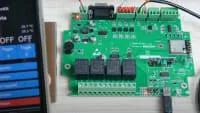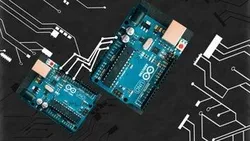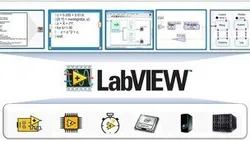
IoT Automation with Arduino IDE by ESP32 board-Part 2 
This online course provides a step-by-step guide to using the Arduino IDE with an ESP32 board to create an IoT automation system, integrating with a third-party open source home automation software. It covers topics such as sensors, WiFi, and the Arduino IDE. ▼
ADVERTISEMENT
Course Feature
![]() Cost:
Cost:
Free
![]() Provider:
Provider:
Udemy
![]() Certificate:
Certificate:
No Information
![]() Language:
Language:
English
Course Overview
❗The content presented here is sourced directly from Udemy platform. For comprehensive course details, including enrollment information, simply click on the 'Go to class' link on our website.
Updated in [March 06th, 2023]
This course provides an overview of the Internet of Things (IoT) automation with Arduino IDE by ESP32 board-Part 2. It is designed to help students understand the basics of home automation with TASMOTA on ESP32, how to use UDP communication over Ethernet with the KC868-A8, how to use the PCF8574 IIC to extend the GPIO for the ESP32 multi relay, how to use the PCF8574 IIC to extend the GPIO for the ESP32 input ports, and how to use ESPhome KC868-A8 ESP32 ethernet work for home assistant.
The course will cover the basics of home automation with TASMOTA on ESP32, including how to use the free MQTT broker server to control the KC868-A4 relay remotely. Students will learn how to use UDP communication over Ethernet with the KC868-A8, and how to use the PCF8574 IIC to extend the GPIO for the ESP32 multi relay and input ports. The course will also cover how to use ESPhome KC868-A8 ESP32 ethernet work for home assistant, and how to build a WiFi repeater using an ESP32.
At the end of the course, students will have a better understanding of the basics of home automation with TASMOTA on ESP32, how to use UDP communication over Ethernet with the KC868-A8, how to use the PCF8574 IIC to extend the GPIO for the ESP32 multi relay and input ports, and how to use ESPhome KC868-A8 ESP32 ethernet work for home assistant. They will also have the skills to build a WiFi repeater using an ESP32.
[Applications]
The application of this course can be seen in the development of home automation systems. With the knowledge gained from this course, users can create a system that can be remotely controlled using MQTT broker server, UDP communication over Ethernet, and PCF8574 IIC. Additionally, users can also build a WiFi repeater using an ESP32. This course provides a great foundation for users to develop their own home automation systems.
[Career Paths]
1. IoT Automation Engineer: IoT Automation Engineers are responsible for designing, developing, and maintaining automated systems that are connected to the Internet of Things (IoT). They must be knowledgeable in programming languages such as C++, Python, and JavaScript, as well as have a strong understanding of networking protocols and hardware. As the demand for IoT automation increases, so does the need for skilled engineers to develop and maintain these systems.
2. Network Security Engineer: Network Security Engineers are responsible for designing, implementing, and maintaining secure networks. They must be knowledgeable in network protocols, encryption, and authentication technologies. As the demand for secure networks increases, so does the need for skilled engineers to develop and maintain these systems.
3. Embedded Systems Engineer: Embedded Systems Engineers are responsible for designing, developing, and maintaining embedded systems. They must be knowledgeable in programming languages such as C, C++, and Assembly, as well as have a strong understanding of hardware and software. As the demand for embedded systems increases, so does the need for skilled engineers to develop and maintain these systems.
4. Robotics Engineer: Robotics Engineers are responsible for designing, developing, and maintaining robotic systems. They must be knowledgeable in programming languages such as C, C++, and Python, as well as have a strong understanding of robotics and automation. As the demand for robotics increases, so does the need for skilled engineers to develop and maintain these systems.
[Education Paths]
1. Electrical Engineering: Electrical engineering is a field of engineering that deals with the study and application of electricity, electronics, and electromagnetism. It is a rapidly developing field, with new technologies and applications being developed every day. Electrical engineers are responsible for designing, developing, and testing electrical systems and components, such as motors, generators, transformers, and power systems. Developing trends in this field include the use of artificial intelligence and machine learning to automate processes, the development of renewable energy sources, and the use of nanotechnology to create smaller and more efficient components.
2. Computer Science: Computer science is the study of computers and their applications. It involves the design, development, and implementation of computer systems and software. Computer scientists are responsible for developing algorithms, designing computer systems, and creating software applications. Developing trends in this field include the use of artificial intelligence and machine learning to automate processes, the development of cloud computing, and the use of blockchain technology to secure data.
3. Robotics: Robotics is the study of robots and their applications. It involves the design, development, and implementation of robotic systems and components. Robotics engineers are responsible for designing, developing, and testing robotic systems and components, such as sensors, actuators, and controllers. Developing trends in this field include the use of artificial intelligence and machine learning to automate processes, the development of autonomous robots, and the use of 3D printing to create robotic components.
4. Mechatronics: Mechatronics is a field of engineering that combines mechanical, electrical, and computer engineering. It involves the design, development, and implementation of mechatronic systems and components. Mechatronics engineers are responsible for designing, developing, and testing mechatronic systems and components, such as motors, sensors, and controllers. Developing trends in this field include the use of artificial intelligence and machine learning to automate processes, the development of autonomous robots, and the use of 3D printing to create mechatronic components.
Pros & Cons

Easy to use Arduino IDE

Comprehensive coverage of ESP32 board

Limited to IoT automation with ESP32 board
Course Provider

Provider Udemy's Stats at AZClass
Discussion and Reviews
0.0 (Based on 0 reviews)
Explore Similar Online Courses

Google Clouds Operations Suite on GKE

UI Design Deep Dives

Python for Informatics: Exploring Information

Social Network Analysis

Introduction to Systematic Review and Meta-Analysis

The Analytics Edge

DCO042 - Python For Informatics

Causal Diagrams: Draw Your Assumptions Before Your Conclusions

Whole genome sequencing of bacterial genomes - tools and applications

Arduino Communication with SPI Protocol

Interfacing LabVIEW With Arduino via LINX

Arduino SMS Sending Motion Detector using Python
 Related Categories
Related Categories
 Popular Providers
Popular Providers
Quiz
 Submitted Sucessfully
Submitted Sucessfully
1. What is the main purpose of this course?
2. Which of the following is not covered in this course?
3. Which of the following is covered in this course?
4. What is KC868-A4?
Correct Answer: It is a relay remotely.


Start your review of IoT Automation with Arduino IDE by ESP32 board-Part 2